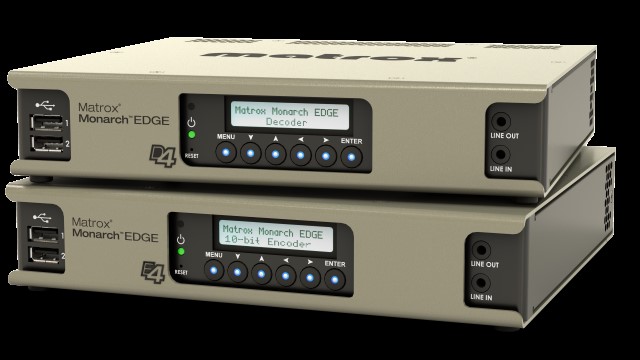Lakeland PBS, a publicly owned PBS affiliate in Minnesota serving a rural and culturally diverse region, is using a Matrox Monarch EDGE E4 encoder and D4 decoder pair to send recorded content over VPN from its remote studio to its headquarters, which are 100 miles apart. With the Monarch EDGE solution, staff members at headquarters can use their production infrastructure to switch studio productions between the two locations, saving time and money.
Lakeland PBS operates two full-power digital television broadcast stations: KAWE at its headquarters in Bemidji and KAWB at its satellite location in Brainerd. When Lakeland PBS produced the live-to-tape show "Lakeland Currents" at its satellite station, staff members from headquarters used to have to travel to the satellite location to record the show and bring the storage drive back to HQ. At about 200 miles and four hours round trip plus production time, it was a costly undertaking.
[How NDI 5 Impacts AVoIP Remote Live Production]
After determining that PC-based solutions with SDI add-in cards weren't robust enough to traverse its VPN, Lakeland PBS decided on a dedicated SRT hardware encoder to ensure stability for remote deployment. The broadcaster chose the Monarch EDGE solution for consistently rock-solid video transmission with good-quality encoding and latency of less than 250 milliseconds from SDI in to SDI out. It is this high performance that makes the broadcaster's Remote Integration (REMI) workflow possible.
"The other option we tested should have worked, but it just didn't quite work. No matter how low we set the bit rate, the transmission wasn't reliable enough. It's got to work all the time if you're going to do a show with it," said Tom Wild, director of engineering at Lakeland PBS. "Adding this SRT encoder definitely was the secret sauce that made reliable video streams and remote production possible."
In the REMI workflow, the remote Monarch EDGE encoder takes three 1080i 60 streams from the station's Panasonic PTZ cameras and transmits the three feeds to headquarters over the VPN as one stream with embedded audio. At HQ, the Monarch EDGE decoder feeds SDI 1080i 59.94 with embedded audio to the station's production switcher.
[Cloud-based Remote Production Optimized—Here's How You Can Do It, Too]
Besides remote production on the live-to-tape shows, Lakeland PBS can also use the Monarch EDGE solution for other remote production purposes, like live hits for nightly newscasts. The broadcaster also appreciates EDGE's talkback functionality, which makes it possible to do intercom through the same box as the encoding/decoding. That capability to communicate with staff was especially helpful when the station covered live debates. And even on remote productions, an IFB makes it possible for someone at HQ to talk to a host at the satellite station.
Thanks to Monarch EDGE, Lakeland PBS has been able to eliminate travel to and from the satellite location, which saves both time and money. Eliminating travel also gives staff a better work-life balance. People can do their work from the headquarters station instead of having to make the long drive. It also alleviates the stress of travel, especially in the middle of a Minnesota winter.
Having a reliable encoding solution also makes it possible for Lakeland PBS to produce more local relevant content for more of its viewers, who, unlike with a metropolitan PBS station, are spread out over a large coverage area.
[Running from Fears in Pro AV]
"We're a pretty small rural PBS station, so every dollar matters. We want to cater to our whole coverage area and make things local and meaningful to our viewers, which can get expensive when our viewing areas are a hundred miles apart," Wild said. "The finances of that being what they are, this technology makes it possible to fulfill that goal. We can say yes to certain shows when we don't have to add another half-day and all the expenses to make it happen."
"Many public television stations operate on a shoestring in terms of budget and staff, so they are looking for ways to work more efficiently," said, Wayne Andrews, product manager at Matrox Video. "This deployment at Lakeland PBS shows how such broadcasters can use Matrox Video technology to make the most of their resources while also improving service to their audiences."
